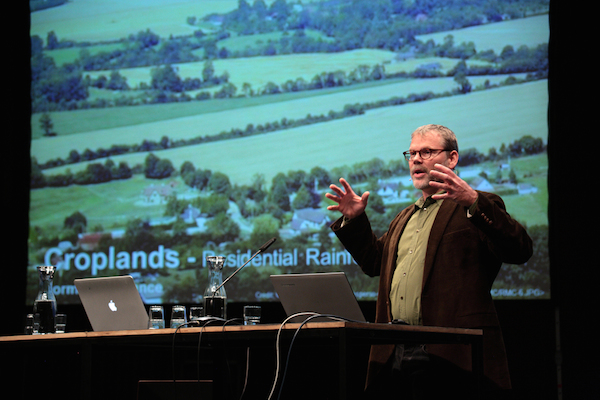A bridge from one side only? Discussing the roots of the Anthropocene
Why did humans, and no other single multicellular species in the history of the Earth, gain the capacity to transform an entire planet? That was the question that Erle Ellis asked in his essay "Evolving toward a better Anthropocene" published on Future Earth's blog in March. The post explored how human evolution helped to give rise to the Anthropocene – a new geologic epoch defined by how people have shaped the planet.
Here, Ninad Bondre and Erle Ellis discuss that post – and disagreements, and potential common ground, among natural and social scientists over how they view this new phase in the planet's history. We encourage you to share your thoughts, too, either in the comments section below or on Facebook and Twitter.
Uncovering the Anthropocene's social roots
Ninad Bondre is the Managing Editor of Elevate Scientific, a science communications company based in Sweden. He was also the Senior Science Editor and Advisor for the International Geopshere-Biosphere Programme (IGBP) from 2009 to 2015. The views expressed here are his own.

Photo: Ninad Bondre
In his recent post on this blog, Erle Ellis provides an interesting theory about how people acquired the capacity to push the Earth into the Anthropocene epoch. According to this theory, human societies create sociocultural niches based on socially learned behaviours. Natural selection acts on these processes and leads to long-term changes in the structure and functioning of human societies as well as profound environmental changes. “Humans are a sociocultural species living in a sociocultural world," Ellis suggests, and calls on us to harness our social and cultural capacities to address the challenges of the Anthropocene.
When I began reading the post, I was pleased to see Ellis’ emphasis on the social – an often overlooked dimension of the Anthropocene. By the time I reached the end, however, it was clear that the focus was on the human species and evolution rather than on human societies and their complex histories. I couldn’t help but being reminded of the recently published Fossil Capital, in which Andreas Malm critiques the dominant thinking about the Anthropocene. Toward the end of the book, Malm notes: “Either the Anthropocene narrative is a form of tacit social Darwinism, or it is founded on a category mistake." Referring to the human species, Malm adds, “It did not figure as an actor on the historical stage.”
Here I want to invite or even provoke the natural-science readership of this blog to engage seriously with Anthropocene scholarship that it might be less familiar with. Although my formal training is in geology, I have spent the past few years collaborating with a number of social scientists and humanists to explore the Anthropocene concept. Moreover, as a former editor of the International Geosphere-Biosphere Programme (IGBP), I am very familiar with the strengths and limitations of the Earth-system science community’s thinking on this concept.
It would be fair to say that in the past few years, social scientists and humanists have been drawn to the Anthropocene concept like moths to a flame. These thinkers have explored Earth’s newest epoch through conferences, workshops and panels. Collectively, they have built up a formidable and diverse body of knowledge, some of which challenges natural-science-centric narratives of the Anthropocene. Ellis does not address, critique or advance this work. This omission is surprising, not least because thinkers such as Clive Hamilton have directly addressed themes such as the “early” and “good” Anthropocene that Ellis has written about.
Some workers, including Eileen Crist, have called out the anthropocentrism – or more strongly put – narcissism underlying the Anthropocene concept. In a paper published some years ago, Crist argues: “By affirming the centrality of man, … the Anthropocene shrinks the discursive space for challenging the domination of the biosphere.” Others, such as Jeremy Baskin, have argued that the scientific representation of the Anthropocene invoke planetary management and legitimise geoengineering.
Then there is the critique of “species-thinking," which, according to Malm, involves “ascribing actions to an entity that could not possibly have performed them.” Ellis, in my view, seems to succumb to this mode of thinking in his post. Although he mentions human societies at numerous places in his blog, his theory still relies on traits that can be seemingly traced back to some fundamental aspects of the human species and its evolution. This limits the extent to which his theory might explain the social triggers of the Anthropocene.
Many researchers including Christophe Bonneuil and Sabine Wilke have cautioned against holding a nebulous humanity culpable for hastening the planet into a new epoch. Two years ago, Wilke and I critiqued the humanity-as-actor notion of the dominant Anthropocene narrative in a post on the Geocritique blog. We pointed out that this narrative “does not address explicitly how the confluence of environmental compulsions, self-interest, exploitation and even sheer chance made some the makers of an epoch and others its unwitting residents.” We went on to add, “the changes in biogeochemical cycles or land use, power asymmetries, capitalism and technology must all be examined as interlinked phenomena.”
By focusing on human evolution rather than human history, Ellis follows many others in naturalising and depoliticising the emergence of the Anthropocene. Agency becomes suprahuman, and historical actors and actions recede into the background. Without considering the dynamics underlying the Industrial Revolution, slavery or globalisation, for example, it’s easy to frame the capacity of human societies to “force the Earth into the Anthropocene” as something unintentional.
Addressing such aspects as power, self-interest, justice and even violence is essential to constructing a history of the emergence of the Anthropocene grounded in real people, real actions and real circumstances. It will also be critical if human societies are to collectively move toward the “better Anthropocene” that Ellis writes about.
Consider, for example, Ellis’ call to “intentionally build better societies and cultures of nature.” If we accept that this needs to be done, how do we go about it? Which type of politics or geopolitics would be needed? Does this need de-growth or green growth? Which technologies should we use and how? Are “we” even at a stage where “we” think of ourselves as a collective unit and can confidently act as one? Who decides among the various courses of action? Who might win and who might lose? These questions aren’t abstractions: some of them have played out in one form or another while writing and implementing climate treaties, for instance.
Note that my exhortations regarding power, justice or politics hold irrespective of my views, or those of social scientists and humanists, on modernity, capitalism, planetary boundaries or technology. They hold whether one views the Anthropocene as an apocalypse or a possibility. Even if you believe in a market- and technology-led transformation to a “better Anthropocene,” you would still need to consider governance, for example, in all its messiness. The “sociocultural strategies to avoid the worst consequences of climate change … and inequality” that Ellis writes about are unlikely to evolve spontaneously. They would require democratic experimentation, new politics as well as technological innovation.
Perhaps Ellis does not deal with all of this because he seeks to identify the “human climate” that shapes biospheric change over centuries to millennia. I believe that in doing so, he dismisses a bit too easily what he terms as “human weather” – “the day-to-day or year-to-year dynamics in social-ecological systems.” If climate is weather averaged over the long term, then surely both need to be considered. Ellis has synthesised insights from a variety of disciplines in his search for the “global forces of humanity.” But the resultant theory of sociocultural niche construction remains limited without considering history, law and sociology, for example, and not just ecology, archaeology or evolution.
To conclude, here’s Malm again, putting more elegantly something I have discussed with colleagues in conversations: “‘The Anthropocene represents an attempt to conceptually traverse the gap between the natural and the social – already blended in reality – through the construction of a bridge from one side only … In Anthropocene thinking," he continues, “natural scientists extend their worldviews to society.” Natural scientists could rectify this by engaging more critically and deeply with the social sciences and the humanities.
Three blind men and the Anthropocene
Erle Ellis is a professor of geography and environmental systems and director of the Laboratory of Anthropogenic Landscape Ecology at the University of Maryland, Baltimore County.

Photo: Erle Ellis
I appreciate Ninad Bondre’s valuable insights on my post. It is good to know that we agree on the need to emphasize social processes in understanding the Anthropocene. Yet I must disagree with the claim that we differ profoundly in our conceptions of humanity. I believe that our differences here represent not a true disagreement but rather a case of three blind men and the Anthropocene – or should I say #manthropocene, a hashtag that's gained popularity recently for describing discussions of the Anthropocene among only, or mostly, men.
Natural scientists, social scientists and humanities scholars are colliding with this great beast, the Anthropocene, and we do this from our different perspectives. Is it surprising that our different disciplines and questions reveal different causes and processes at work?
My post introduces a new theory rooted in the natural sciences, sociocultural niche construction, that engages with the social sciences to explain why humans alone among multicellular species gained the capacity to alter the trajectory of the Earth system and why different human societies have transformed ecology in so many different ways over the past 50,000 years. In contrast, Bondre’s critique is rooted in the humanities and the social sciences and focuses on questions of “power, justice or politics”.
A deeper look at sociocultural niche construction will clarify its firm connections with theory in the social sciences from structuration to world systems. Most importantly, this theory presents behaviourally modern humans as Earth’s first ultrasocial species – a species that must live within its social worlds as a fish must live in water. For our species, politics are therefore inescapable. I heartily agree that there are political consequences to defining a “nebulous humanity” as the cause of very real and very important social and environmental inequalities in the Anthropocene – and I do not make this mistake.
Clearly, “Critical and interpretative social science may re-politicize the Anthropocene." But does this mean that politics is the only useful framework for understanding the emergence and dynamics of human social processes in the Anthropocene?
It is easy to critique across disciplines; much harder to find common agreements, common aims and common strengths. Can we clarify together scholarly spaces where the politics of the Anthropocene are essential – and where they are not? Can useful spaces of agreement and disagreement be identified and engaged with?
There is a politics of biology and a politics of geophysics. There is also politics in biology and there is politics in geophysics. But is that all there is? Is there nothing to be gained from biology and geophysics that goes beyond the politics of particular times and places?
It will always be necessary for us humans to swim in our own particular political seas. But let us also keep learning socially, together, across societies and across generations. In exploring the emergence and dynamics of human sociocultural processes across Earth from prehistory to present, there is great opportunity to learn much that is new and relevant.
DATE
May 11, 2016AUTHOR
Erle EllisNinad Bondre
SHARE WITH YOUR NETWORK
RELATED POSTS
Spotlight on LMICs – Tired of Breathing in Pollutants? Time for Better Fuel Economy and Vehicle Standards
Future Earth Taipei Holds 2024 Annual Symposium
Spotlight on LMICs – The Future’s Juggernaut: Positioning Research as Anchors for Environmental Health